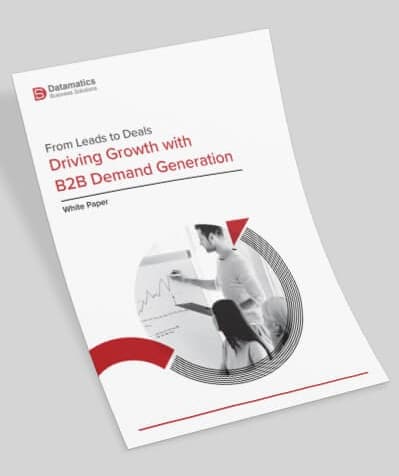Have you ever wondered how a customer makes a buying decision? Or complete the actual purchase? If we glance at it from the customer’s point of view, it seems like simple demand and supply situation. Whereas, from the seller’s point of view, it’s a comprehensive sales journey, which can be depicted in a sales funnel. The buyer travels through it to make the final purchase.
Developed by E St Elmo Lewis in 1898, the sales funnel concept is one of the first formal marketing theories. B2B sales funnel maps the entire lead to customer journey by capturing how the buyer moves through the various buying stages and makes the buying decision. These insights enable marketers to reach out to the prospects at the right time with the right messaging at different points of the sales process. Sounds interesting, right!
So, let’s dive deeper and unearth crucial aspects of the B2B sales funnel:
- What is B2B Sales Funnel?
- Why having a B2B Sales funnel is a must for businesses?
- How to create sales funnel?
What is B2B Sales Funnel?
A B2B sales funnel a streamlined process representing customers’ buying journey, from the early stage of brand discovery to the final purchase. Most companies utilize funnels to map prospects through various buying stages to adjust their marketing tactics and strategies as per the prospects’ responses. The primary objective of the sales funnel is to keep the company’s value on top of the prospects’ minds and transform them into buyers. To get a precise understanding of the B2B sales funnels, consider the three critical processes involved:
- Buying – Looking for a solution for a business challenge
- Selling – Seeking and communicating with the customers who are facing pain points
- Marketing – Understanding the buyer’s challenges/pain points, educating the prospects, and helping the sellers to promote product/service
B2B sales funnel an interconnection of these three processes. However, it differs from company to company. Indeed, you can’t force the buying process on a prospect, but you can influence through a well-structured marketing strategy. A sales funnel is an excellent starting point in the journey. Here are a few more reasons why businesses must have sales funnel.
Why having a sales funnel is ‘A MUST’ for businesses?
The sales funnel enables businesses to visualize each step that prospects would take on the path of conversion. Every step defines different goals and actions you need to take to achieve the end goal. It is a valuable framework to analyze your business’s sales mechanism and identify areas for improvement. For instance, through a sales funnel, an e-Commerce website might locate a significant drop-off in the number of website visitors using the shopping cart or establish the number of people who are genuinely making a transaction. Using this insight into the buying journey, the company can make some timely interventions to improve the conversion rate. Let’s understand each stage of this funnel in detail:
Stages of a Sales Funnel
There are the three main stages of the sales funnel:
- Awareness – Top of the funnel, also known as TOFU
- Interest – Middle of the funnel abbreviated as MOFU
- Decision – The bottom of the funnel is often referred to as BOFU
Awareness
This is the first stage where your target audience becomes aware of your offerings through an online search, ad, content, social media sites, or other traffic sources. It may be the same time when they become aware of the challenges they need to overcome.
The key actions prospects might take in this stage are:
- Visit your website
- Check out your social media channels
- Watch demo video or download content (infographic, eBook, whitepaper, etc.)
Interest
At this stage, the prospects know about you. If the prospects actively searching for a solution to achieve their end objective, they will evaluate your brand based on their interest levels.
The key actions a prospect might take in this stage are:
- Start opening emails sent by your brand to know more about the offering
- Compare product features and pricing with other competitors’ offerings
- Sign up for a free trial or demo
Decision
The most crucial funnel stage is where the prospects decide and purchase the products. Your hot leads turn into new customers.
The key actions a prospect might take in this stage are:
- Give a verbal/email confirmation
- Negotiate on the pricing/features
- Make the final purchase
- Renew the contract
- Fill out the customer satisfaction survey
- Engage cross-sell/upsell campaign
How to create Sales Funnels?
There are several ways to build a sales funnel. Different industries and businesses have their own sales funnels; however, everyone follows some common steps to create a funnel. Let’s walk you down those steps:
Know Your Buyers
If your target audience is everybody, then your target audience is nobody. Every customer is different, and so is their customer journey. Hence, first and foremost, identify your ideal customer profile and create a buyer persona. Find out their goals, behavior, demographics, motivations, etc., and reach out to them with the targeted content that resonates with them. Perform surveys, brainstorm with your sales team, and track the website and social media visitors to create different and precise buyer personas to enhance every customer’s buying journey.
Grab Your Buyers’ Attention
Practically, your buyers have countless options but less time to explore every one. Also, it will be too late if you wait for them to make the purchase decision. Hence, try to build top-of-mind awareness among your buyers. Start publishing informative and engaging content in front of the customers even before they realize they need your product. Whenever a pain point surfaces, they would already have you in the consideration set.
Offering tailormade content per the buyer persona ensures that the customer won’t ignore you by seeing irrelevant content. By analyzing the resources existing customers have predominantly used and tracking at which stage they acted, you can generate content and engage the prospects. Once you understand what content they are interested in, serve downloadable lead magnets and other gated content to encourage them to share their profile details. You can stay on top of their minds by engaging them with email campaigns highlighting your expertise.
Bring Your Buyers on the Landing Page
Business owners must have website landing pages as a gateway to their services and products. Implementing a 360-degree digital marketing strategy can help businesses get more website visitors. A bespoke landing page can be the first touchpoint where prospects can learn about the products/services by clicking on a social media page link or ad, reading a blog, or downloading an e-book. The landing page sets the first impression of your business, so make it substantial and impressive. It should capture the visitor’s contact details so you can keep communicating your value to them.
Market & Sell to Your Buyers
Now, the time is to do what we are meant to do, ‘MARKETING.’ You need to start communicating and marketing your product/service to the leads arriving on the landing page to close them. Reach out to your information through email marketing by extending informative and engaging content. Stay in touch with them regularly but not too frequently, sending updates. Instead of focused marketing, you can start connecting with prospects by educating them. Engage them with informative content rather than direct promotional content. Resolve their questions and doubts to build a relationship and then make a sales pitch later. The content will subconsciously push your prospects toward the purchase decision.
Keep Communicating with Your Buyer
Don’t forget your customers, who were your prospects. Frequently reach out to them with valuable content such as blogs, podcasts, videos, customer testimonials, listicles, how-to guides, case studies, etc. Send out regular updates on your product features, services, and promotions. Make them a part of your social media community to grow brand trust and loyalty.
 Select an element to maximize. Press ESC to cancel.
Select an element to maximize. Press ESC to cancel. Select an element to maximize. Press ESC to cancel.
Select an element to maximize. Press ESC to cancel. Select an element to maximize. Press ESC to cancel.
Select an element to maximize. Press ESC to cancel. Select an element to maximize. Press ESC to cancel.
Select an element to maximize. Press ESC to cancel. Select an element to maximize. Press ESC to cancel.
Select an element to maximize. Press ESC to cancel.Takeaway
Creating a sales funnel doesn’t mean your work is done. This is where the actual work begins. Once a sales funnel is set up, it is essential to measure the results. Take a reasonable amount of time to build a sales funnel that is a fine blend of your and your customers’ needs. Indeed, building a sales funnel ecosystem and keeping it flowing is more accessible than done. It requires a dedicated and streamlined B2B lead generation program across every funnel stage to accelerate audience reach, improve engagement, nurture prospects, and generate quality leads.
If your efforts aren’t giving the desired results, find the leaks in the funnel and plug them in by gathering and analyzing data to achieve better outcomes. If you have doubts and queries on your mind, reach out to our B2B Lead Generation experts, and we’d be happy to help.
 Select an element to maximize. Press ESC to cancel.
Select an element to maximize. Press ESC to cancel. Select an element to maximize. Press ESC to cancel.
Select an element to maximize. Press ESC to cancel. Select an element to maximize. Press ESC to cancel.
Select an element to maximize. Press ESC to cancel.
Hemant Jain



